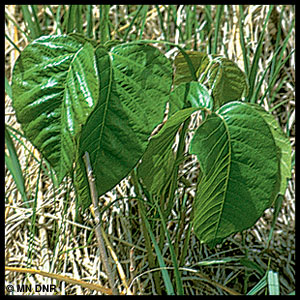Here is a picture of PI that I'm used to seeing. This stuff only grows 4-8" tall and has oily shinny leaves. I've never seen it as a vine.
When I was reading that PI grows as a vine, I got a bit alarmed because the woods that I'm cutting is full of vines. I'm glad someone from WI chimed in about PI vines not growing in our area. Now I know what Tarzan swung on!
 Leaves of three, let them be
Leaves of three, let them be. Also, if you don't have TP and you're out in the woods, make sure you know which
vegetation you choose to use!
The picture came from here:
MN DNR
Here is what they say about it:
Not a true ivy plant, western poison ivy is well known for producing a skin irritant.
Identification
General description: Western poison ivy is a smallish,
nonclimbing shrub usually about knee high, with a single stem and only a few stubby branches or no branches at all.
Leaves: The leaves can be relatively large but always with three leaflets. Virginia creeper (Parthenocissus quinquefolia) and woodbine (P. vitacea) are similar but have 5 leaflets instead of 3. Jack-in-the-pulpit (Arisaema triphyllum) and the trilliums (Trillium spp.) do have 3 leaflets, but they have nonwoody stems. It may be enough to keep in mind that western poison ivy has a short woody stem and 3 leaflets.
Habitat and range
Western poison ivy occurs essentially statewide and is common everywhere except the northern tier of counties. Although it is primarily a forest species, it is adapted to a remarkably wide range of ecological conditions. It occurs in the interior of mature hardwood forests but also in young successional forests, forest ecotones, and brushy thickets. It is also found in native prairies (where fire has been suppressed), sand dunes, talus, rock fields, and floodplains. It seems to be absent only from permanently wet habitats.
Population and management
Western poison ivy often forms colonies, sometimes 20 ft (6 m) or more across. They grow quickly and can spread aggressively, especially in damaged habitats. This is certainly the case on roadsides, ditch banks, utility rights-of-way, and old fields. It is also notoriously adept at encroaching into mowed lawns from adjacent woods.
About the poison
The sap contains a toxic oily compound (3-n-pentadecyl-catechol) that is found in the leaves, flowers, stems, and roots. If any portion of the plant is bruised or broken, the poison may exude onto the surface, which is how people typically come in contact with it. It is initially a clear liquid, but it turns into a black gummy substance in a few hours and can remain toxic for an indefinite period, reportedly for several hundred years.
Contact may be direct between plant and bare skin, or the poison may travel on the fur of a dog, camping equipment, clothing, or other intermediary. The compound is not volatile, so it is not normally transmitted through the air, although it can be carried as droplets on particles of ash in the smoke of burning plants. Such particles are sometimes inhaled, causing serious problems, or they can settle on surfaces and be picked up from there.
Sensitivity to poisoning can vary from individual to individual and can change over time. Very few individuals are immune, and those that appear so could easily lose their immunity unexpectedly. The poison is absorbed by the skin almost immediately, although symptoms may not appear for 12 to 24 hours or in some cases several days. Washing the exposed skin with soap and cold water (warm water speeds absorption through the skin) probably will not prevent symptoms from appearing unless done with 1 to 3 minutes after exposure, but washing can remove residual poison and prevent it from being spread. The fluid in the blisters does not contain the poison and cannot spread the rash. A number of animal species regularly eat the fruit and leaves with no apparent harmful effects; in fact, it appears that only humans are susceptible.






